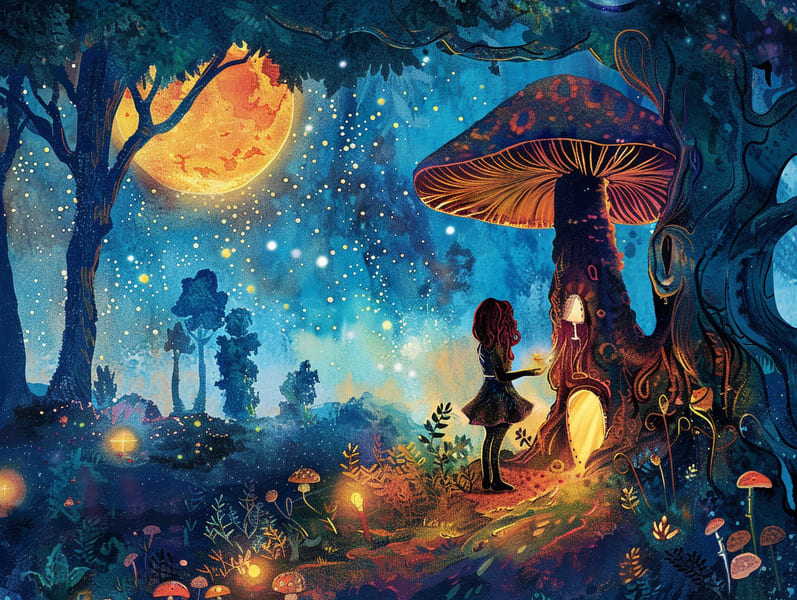Exploring the Roots of Mythical Fairy Tales with Their Ageless Fascination.
Exploring the Roots of Mythical Fairy Tales with Their Ageless Fascination.
Blog Article

Fairy tales for kids have timeless appeal. These tales have been narrated from one generation to the next centuries before they were ever transcribed. They arose from a variety of civilizations, including Indigenous traditions. They were initially shared among mature audiences, often carrying themes and messages related to the societal norms and beliefs of the time.
The famous Grimm duo, Jacob and Wilhelm Grimm, were among the first to gather and publish many of these beloved narratives. Their published works, "Grimm's Story Collection," included narratives like "Cinderella," "The Story of Hansel and Gretel," and "Snow White," which have since become classics in the world of traditional fairy tales. Similarly, Andersen's imaginative stories, such as "The Little Mermaid," and "The Duckling's Story," have captivated hearts worldwide, guaranteeing their place in the pantheon of beloved fairy tales.
Despite being ancient, these stories remain as significant as ever, especially as children's bedtime stories. These delightful tales are now available in diverse formats, including gorgeously illustrated books, fantastical animations, and online fairy tales.
Their lasting appeal can be ascribed to several fascinating points:
Important Morals: Traditional fairy tales often illustrate important moral lessons. Fairy tales like "The Tale of the Boy Who Cried Wolf" teach the value of truthfulness, while "The Tale of the Tortoise and the Hare" point out the merits of resolve and meekness. These tales offer children clear distinctions between ethical and unethical, building their moral compass in a kind yet lasting way.
Kindness and Comprehension: Traditional fairy tales frequently depict heroes facing difficulties and adversities, stimulating listeners to connect with their struggles and encourage their triumphs. For instance, "The Tale of Beauty and the Beast" conveys the value of seeing beyond looks to comprehend the true being of a person, developing kindness and comprehension.
Cultural Knowledge: Many ancient fairy tales are interwoven with the cultural contexts from which they bloomed. Immersing in these tales can provide captivating looks into different cultures, cultivating a sense of international awareness and respect.
Inventiveness and Imagination: The whimsical elements in classic fairy tales—wizardry and magic—ignite children’s creative dreams. These stories carry readers to fantasy realms, boosting creative thinking and a sense of wonder that remains a lifetime.
Old fairy tales are not only mesmerizing but also pedagogical. They function as magical tools in advancing various intellectual and emotional more info capacities in young ones. When traditional fairy tales are spoken out loud, they foster language development by introducing new language and detailed sentence structures. This practice also improves hearing abilities and attention, as kids concentrate deeply, anticipating to see what happens next.
Furthermore, talking about the themes and characters of ancient fairy tales can advance analytical skills and critical thinking. Children are educated to find patterns, predict happenings, and know cause and effect. These talks also benefit kids say their thoughts and feelings, advancing their emotional intelligence.
In today’s digital age, the accessibility of web-based fairy tales has made these stories more available than ever. Online resources and mobile apps present extensive collections of timeless fairy tales that can be read or heard anytime, anywhere. Fairy tales read aloud are particularly liked, offering an fun way for kids to engage with these delightful tales. Voice books and narrated videos transport characters and settings to life, often augmented by delightful music and songs that elevate the narrative experience.
The timeless appeal of traditional fairy tales lies in their ability to adapt to the present while keeping their fundamental ideas. Contemporary reinterpretations of these narratives often showcase more diverse protagonists and modern settings, making them understandable to today’s audience. However, the central morals of fortitude, warmth, and honesty remain unchanged, continuing to resonate with children of all ages.
Traditional fairy tales also offer a sense of protection and familiarity. They grant access to a orderly narrative with a evident beginning, middle, and end, often coming to a close with the solving of conflicts and the triumph of righteousness over wickedness. This constancy can be solacing for young ones, extending a sense of invariability in an ever-changing world.
Classic fairy tales continue to mesmerize and teach new generations, maintaining their spell and impact in modern society. As bedtime stories for kids, they make accessible a perfect blend of fascination and comprehension, nurturing moral values, empathy, and creativity. The abundance of digital storybooks and the commonness of fairy tales read aloud warrant that these traditional narratives remain attainable to new generations.
By protecting and imparting these fairy tales, we continue to esteem the rich tapestry of narrative artistry and cultural heritage. Whether you are seeing a beautifully illustrated book, enjoying a digital collection, or listening via an read-aloud book, the beauty of bedtime fairy tales is always within reach. These stories convey of the unwavering strength of stories and its ability to unify us across generations and cultures.
No matter if you are delving into a richly illustrated book, viewing a electronic collection, or listening to an sound book, the wonder of bedtime fairy tales is always within reach.
These narratives emphasize of the unceasing magic of tales and its ability to tie us across centuries and lands, forging a link that fascinates and enlightens alike.